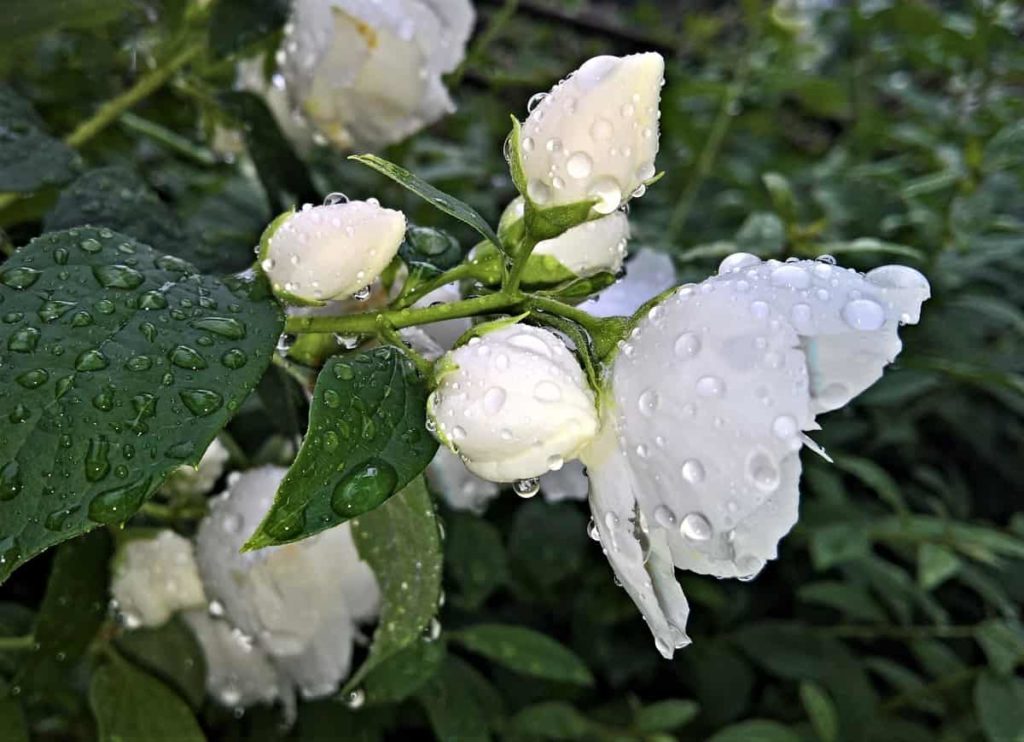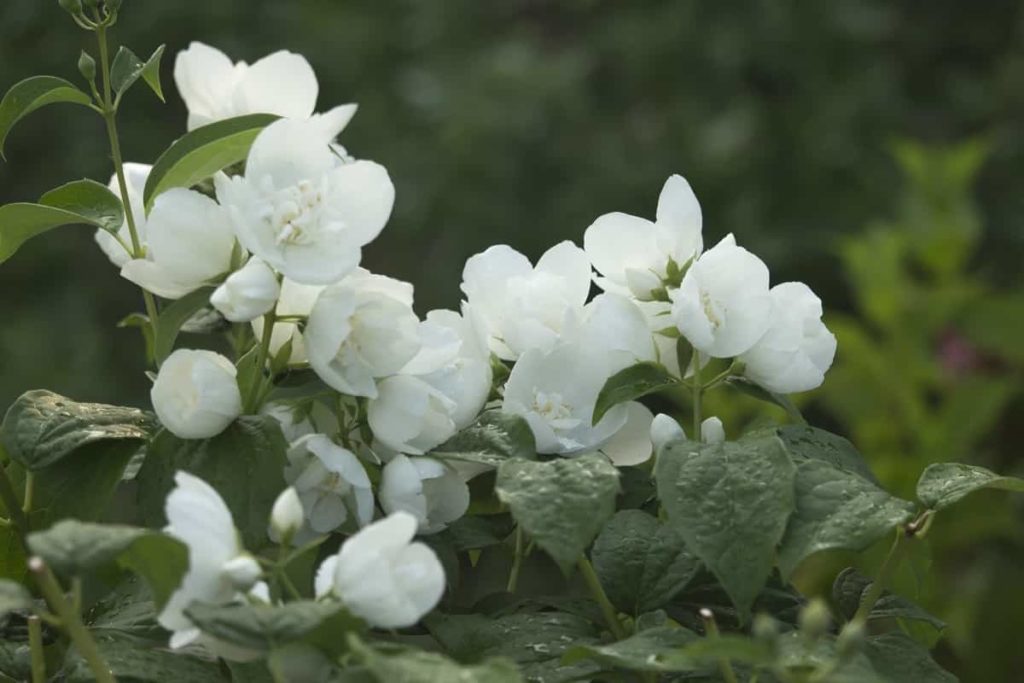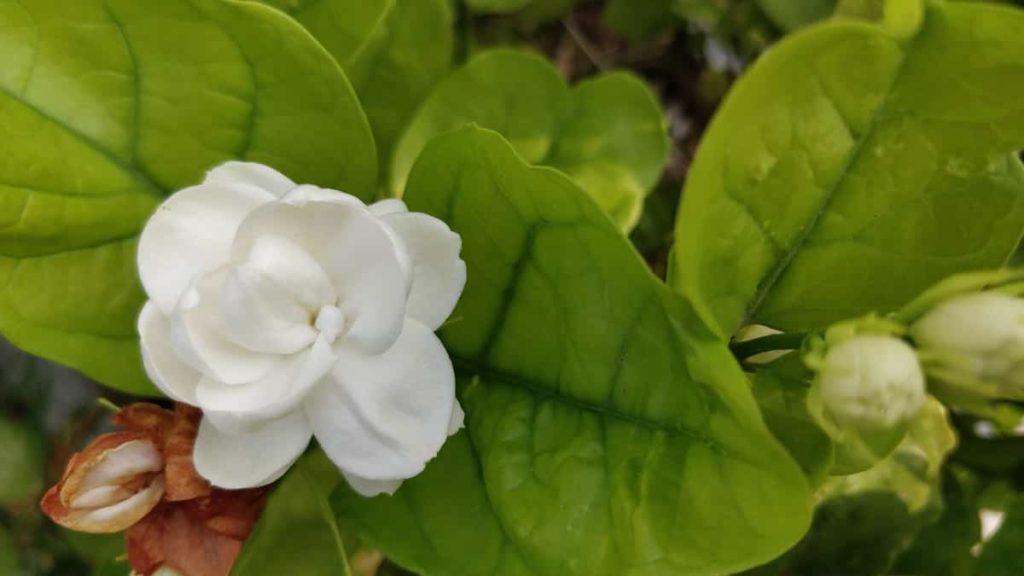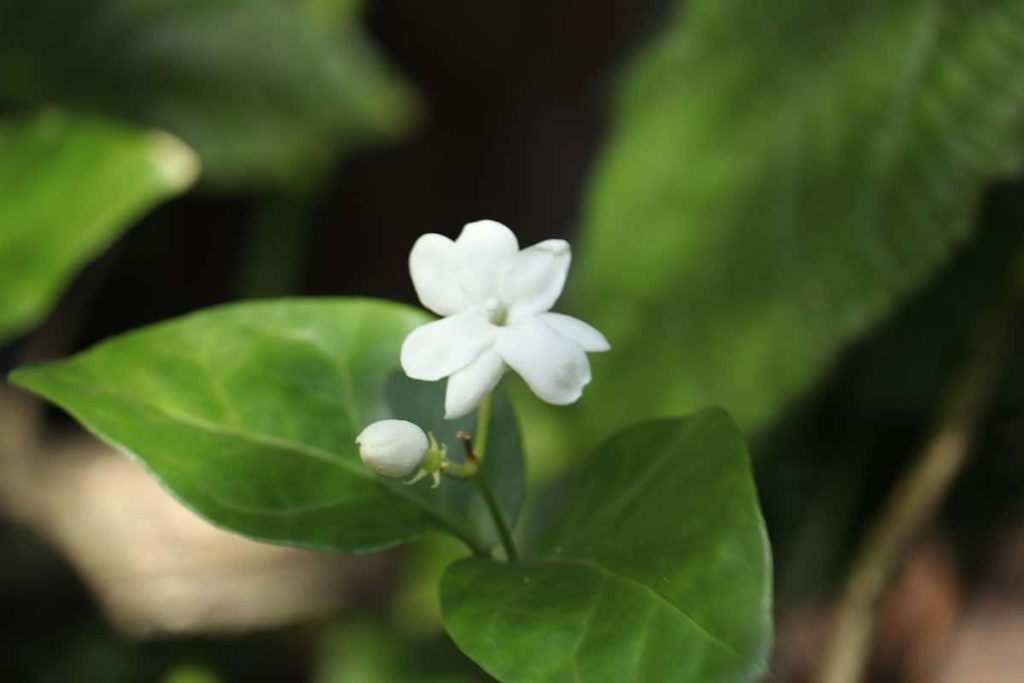Once you’ve grown a fragrant, easy-to-care common Jasmine plant, you can easily propagate cuttings from it to use throughout your garden, in pots, or on the ground. As long as you give Jasmine a partial shade and medium water with full sun, the plant will thrive from a cutting. Jasmine makes a beautiful addition to your home or garden.

When it blooms, it produces delicate, fragrant buds. You can easily grow Jasmine from cuttings taken from a healthy plant. First, you’ll need to take cuttings from an existing Jasmine plant and encourage them to take root. After that, you can plant and take care of them for your cutting.
How to plant jasmine from cuttings
Can I grow Jasmine from a cutting?
- You can propagate Jasmine by cutting, layering, sucker, grafting, budding, and tissue culture. Plants like Roses and Jasmine do not produce viable seeds. Therefore, they are grown by artificial vegetative propagation.
- You can grow Jasmine easily. If you’re buying a Jasmine plant from a nursery or garden center, look for one with rich, healthy shoots and leaves. You can plant summer Jasmine in your garden in spring or autumn, although less hardy varieties should be protected or kept in a greenhouse in the winter.
- Jasmine can be propagated by layering or cuttings. Outdoor varieties are best propagated from hardwood cuttings taken in winter, but tender varieties work best with softwood or semi-ripe cuttings in spring or summer.
- Start by cutting stem tips from a healthy Jasmine plant if you want to propagate Jasmine by cutting instead of rooting. Make the cutting about 6 inches long, and cut each one directly under one leaf. Jasmine cutting usually takes about four to six weeks to take root, although this time may vary.
In case you missed it: 13 Common Jasmine Plant Problems: How to Fix Them, Solutions, and Treatment

Can Jasmine be grown from layering?
- Jasmine with vining habit and a low or flexible branch that can easily reach the ground is suitable for propagation using tip layering. Jasmine plants can be propagated using the layering method in which a branch is allowed to grow in the soil while attaching to the main plant.
- The process of stem layering carries out propagation in plants such as Lemons, Jasmine, and Grapes. Layering is a plant propagation in which a portion of the aerial stem grows the roots while still attaching to the parent plant and then separated as an independent plant.
- Jasmine, Grapes, and Gooseberries are all propagated by simple or ground layering. In this process, a branch of high vigor is selected, bent, and buried in the ground. The ground should be kept moist. Once the roots emerge and grow, the stem is cut off and planted at a distance from the mother plant.
- For the preparation of layers, well-matured, one-year-old shoots are selected and buried 10 to 15 centimeters deep in the soil after forming a shallow, slanting cut in the portion. It will form roots in 90 to 120 days.
Growing Jasmine from cutting
- Take a small pot, 3 to 4 inches, and fill it with a well-drained potting mix. Water well and leave the pot for an hour to drain.
- Look for a semi-hardwood stem that should be firm and wooden but flexible enough to bend. Cut the pencil-shaped stem just below the node with a sharp knife. Remove all leaves from one-third of the bottom of the stem. Make the cutting about 6 inches long, and cut each one directly under one leaf. Remove the leaves from the bottom of the cutting and dip them in the rooting hormone powder.
- You should make a hole in the middle of the pot using a stick and carefully insert the Jasmine stem into the soil so that at least two nodes are in the soil. Do not push the stem into the soil to avoid any damage to the cutting. Don’t water again.
- Cover the pot inside a clean polythene bag to maintain moisture and keep it in a bright spot but directly out of the sun. Open the cover periodically, after every ten days, to allow fresh air. You can moisten the soil a bit. Do not water too much because there are no roots yet; otherwise, the stem will rot.
- Within 5 to 6 weeks, new developments will emerge. Take out the pot and let it remain in indirect sunlight until 2 to 3 sets of leaves appear. Carefully transplant the new plant into another pot or ground.
In case you missed it: Growth Stages of Flowering Plants: Rose, Marigold, Hibiscus, Dahlia, Gerbera Daisy, and Jasmine

How do you make Jasmine grow faster?
- To grow Jasmine, plant in rich, well-drained soil in a place that is partial to full sun. Keep the soil around Jasmine moist during the growing season, and fertilize your plants monthly to encourage more blooming.
- Grow Jasmine in moist but well-drained soil in full sunlight, with strong support such as trellis or wires. You should feed weekly with a high potash fertilizer in summer and mulch with well-rotted manure or leaf mold in the fall. Cut back after flowering.
Soil requirement for growing Jasmine from cuttings
- You can grow Jasmine in a wide range of soils. Jasmine prefers well-drained but moist, moderately fertile sandy loamy soil. Fill a pot with well-drained soil. Jasmine needs soil with plenty of drainages to grow. To improve drainage, you should fill the pot with a well-drained potting mix or add loam-based compost to the soil.
- Jasmine plant requires nutrient-rich, free-draining soil. About 25% each of cow manure or compost and river sand or perlite in the potting mix for this mix.
- If you have highly alkaline soil, this imbalance can cause yellow leaves. Applying sulfur or adding woody organic matter can help balance the pH, but be sure to check your soil before you attempt to make corrections.
Should I prune Jasmine?
- The annual pruning will help keep the Jasmine plants healthy and rich, with flowers lower down where their scent can be enjoyed. Pruning is necessary to keep them within their allocated space and prevent growth from becoming too straggly, tangled, or congested.
- Jasmine can withstand hard pruning. If your Jasmine has outgrown its space, you can cut the entire plant within 2 feet of the ground level. Choose firm, healthy shoots to retrain on your wall or fence. Once cut this way, your Jasmine may not flower again for 2 or 3 years.
- In summer and early fall, summer Jasmine blooms, and winter Jasmine blooms in late winter and early spring on the vines developed in the previous season. Prune them immediately after flowers to give them time to promote growth for the next flowering season.
- At the end of the summer, Jasmine is best pruned after flowering. This leaves enough time for new growth time to mature. If you don’t remove dead flowers and branches, your Jasmine will stop growing. Pinch the dead flowers and cut the non-flowering branches to the base of the stem. If your Jasmine is drooping leaves, it may be a sign that it’s not getting enough sun.
In case you missed it: How to Grow Jasmine Flowers at Home in the USA: From Seeds, Cuttings, Faster, In Backyards, Indoors, and In Containers

How can I make my Jasmine flower more?
- Prune your Jasmine plant after the blooms finish. If you can’t prune at this time, ensure the pruning is done by mid-summer. Later pruning can remove season buds that are already forming. Heavy pruning is encouraged for this plant. If done correctly, it will encourage more and more large blooms.
- Let the soil moisten during the summer and dry between the water. When fertilizing the Jasmine plant, use a fertilizer rich in potassium and phosphorus. When you start seeing new growth on the Jasmine plant, you should start pinching the stems to promote growth.
- Keep the temperature at four °C to 10°C during the resting time for Jasmine flowers that are not blooming. When flowers appear on a Jasmine plant that isn’t blooming, move it to an area where it receives six hours of light daily.
- Proper moisture in the soil is essential for Jasmine’s proper growth and flowering. After flowering, no irrigation is usually required until after the subsequent pruning and manuring.
Can you grow Jasmine indoors?
- Indoors, space near the south window and provide a trellis or support. Indoors, Jasmine needs to stay cool with well-circulated air. Try to keep the temperature between 15°C to 23°C. Plant Jasmine on porous materials and bark, peat, and other soils that drain well.
- Dwarf varieties perform best indoors, but vines can also thrive indoors. Just pinch or prune the plant in the dormant season to maintain the desired height and shape.
- The plant requires 4 to 5 weeks of night-time temperatures between 4°C to 10°C, plenty of sunlight, and the complete absence of artificial light after sundown. Bring the plant indoors before the frost. Then give it cool temperatures and indirect light until it blooms again in the late winter.
Fertilizer requirement for growing Jasmine from cutting
- A 7-9-5 fertilizer works best for growing Jasmine plants. It is 7% nitrogen, which ensures green, healthy, green leaves, abundant phosphorus, 9% for large flowers, and 5% potassium for strong roots and better resistance to diseases, pests, and drought.
- Start fertilizing the Jasmine after the new growth emerges, but before the flower buds appear. You should fertilize Jasmine every four to six weeks during its growing season.
- Jasmine plants in the garden generally do not require additional fertilizer unless they are in nutrient-poor soil. As a rule, the thick organic mulch applied around the plant’s root zone will gradually leach and fertilize the soil and feed the roots. To promote flowering, feed with a high potassium liquid feed.
- The soil should always be a little moist but not soggy. You should fertilize Jasmine twice a year with potassium and phosphorus-rich fertilizer. During the spring and summer growing seasons, liquid fertilizer can be fed to the plant every few weeks.
- Jasmine plant needs slightly acidic soil with a pH range of 5 to 8. Therefore, its supplementation with coffee grounds may be the best bet. Coffee grounds contain nitrogen, magnesium, and potassium, which increase soil acidity.
How do I make my Jasmine plant bushy?
- You can use plant ties or weave them just through trellis sections. Fertilize the plant in the spring before new growth appears. Pinch off vine tips in the second year to promote branches that will fill the trellis with shrub growth.
- You should prune immediately after flowering. Give the summer Jasmine a hard prune annually in late or early autumn. The winter Jasmine requires a heavy prune in late spring, shortly after blooming. Start pinching the upper half inch of the stems by squeezing between your thumbnail and finger when young plants begin to put out new growth. Punching the tips, especially in the first two years, promotes rapid growth and lush vegetation.
In case you missed it: Jasmine Gardening For Beginners – How to Start, FAQs

Do Jasmine plants have deep roots?
- The root system of the Jasmine vines proliferates with runners, so wherever the plant touches the ground, it puts the roots down. These roots form a deep network that covers the entire area where the plant grows. Tap roots are longer and thicker with greater surface area and reach deeper soil layers. Therefore, they are more efficient at absorbing water from deeper layers. Therefore, plants with taproots need more water for their growth and development.
- Place the plants at a distance of 4 feet. Keep the soil moist in the first growing season as soon as the roots are established. After planting, you should add two inches of mulch to conserve moisture in dry conditions.
Why is my Jasmine not flowering?
- Jasmine is not flowering, usually due to drought stress, too much nitrogen in the soil, or pruning at the wrong time of year. Pruning Jasmine in spring or summer can remove the growth at which the flowers grow.
- Non-flowered Jasmine may be living in the wrong growing conditions. The light and the right temperature are necessary to bloom Jasmine, which is not flowery.
- Jasmine will flower in 6 hours of direct sun or more during spring or summer, but more sun is better for flowering and plant health. Jasmine can be under stress with less than 6 hours of direct sunlight and doesn’t have the energy to flower.
Growing Jasmine in pots
- Jasmine is grown in well-drained soil and gets plenty of sun and water, so it adapts well to container gardening ideas. A loam-based compost is a good choice because water also holds well in addition to its extra nutrients. Try growing Jasmine in the pot against the sunny wall.
- For best results, grow Jasmine near the wall or fence in a shelter, sunny, moist, but well-drained soil. Wide varieties will tolerate shade, but they work best throughout the sun. You can also grow Jasmine in large pots. Place young Jasmine in a 6-inch pot with drainage holes and a trellis or hoop on which the vines can climb.
Can I root Jasmine in water?
Jasmine cutting can also be rooted in water, but water propagation can be ineffective. You’ll want to dip the cut end of your cutting with exposed nodes in water. You must change your water each time to prevent any build-up in the water from damaging your cutting.
Water requirement for growing Jasmine from cuttings
- When Jasmines bloom, they require plenty of water. It is always better to keep the soil a little moist. Plants should be watered weekly, but water the plant quickly if the soil dries before that.
- Water the Jasmine plants immediately after planting them in the soil. Water the plant daily (early in the morning) in small amounts or weekly in large quantities (2 inches per week). Before watering the plant, make sure the soil is completely dry.
- If your Jasmine gets too little water, the roots can’t move through the soil and collect nutrients. If you always leave a puddle of water under the planter, the roots can suffer from rot.
- If Jasmine grows as a houseplant, the soil should be moist and well-drained, but there is not much water. Let the soil moisten during the summer and dry between the water. Keep the plant slightly dry during the winter and spring months. Feel the surface of the soil beneath the Jasmine plant to see if it’s soggy. If so, the plant may suffer from more water. If the Jasmine is potted, repot it into fresh soil. If Jasmine is in the ground, stop watering it until the upper 4 or 5 inches of soil is dry to touch.
What type of trellis is best for Jasmine?
- The easiest way to cultivate Jasmine on a trellis is to use a container trellis. Use a small structure that will fit into a pot or other container to grow your plant. This advantage is that if the temperature freezes where you live, you can move it to winter.
- You should use a lightweight trellis to create some privacy on your porch or outdoor area. Alternatively, you can use a strong frame to extend hard types of Jasmine, which can grow much longer and provide privacy and protection from wind.
- Jasmine must be supported on arbors or trellis if grown as twin vines. The common Jasmine grows as a long, semi-vining shrub from 10 to 15 feet, growing 12 to 24 inches a year.
In case you missed it: Homemade Fertilizers For Jasmine – Organic/Natural

Does Jasmine need full sun?
- Jasmine requires full sun or partial shade, usually about 6 hours or more of direct sunlight per day for full sunlight and 2 to 4 hours per day for partial shade. In addition to the climate and other conditions, the kind of Jasmine you plant will determine how much sun the plant needs.
- You should choose a planting site that receives at least eight hours of bright sunlight daily. Fertile, well-drained soil is also perfect for growing these vines. In well-drained soil of average fertility, plant Jasmine in partial sunlight. Keep it evenly moist. It grows outside and in a container plant or well-lit indoor spaces. Several varieties will tolerate low light but bloom less under low light conditions.
When can I move a Jasmine plant?
- Early fall is the best season to transplant Jasmine. Spring is also acceptable, although plants won’t have enough time to recover before the summer heat begins. Jasmine can be replanted at any time of the year, but for the best flowers, it’s better to replant them in the spring or summer months of the year.
- You can plant Jasmine bushes anytime between June and November. Jasmine will grow well in full sunlight in partially shaded areas. Summer-flowered Jasmine works better in a sunny spot, while other varieties, such as winter Jasmine, work better in a more-shady area.
Why is my Jasmine dying?
- Excessive water has caused root rot, causing the leaves to wilt and turn yellow, not bloom, and poor growth. The roots of your Jasmine plants also need air. If you overwater the plant, it will suffocate and eventually die. So, it is better to water your plants carefully.
- If your Jasmine gets too little water, the roots can’t move through the soil and collect nutrients. Excess water can also be bad for your plant. If you always leave a puddle of water under the planter, the roots can suffer from rot.
Conclusion
Jasmine flowers bloom in summer and are known for their exotic fragrance on warm evenings. Not all Jasmines are fragrant, although there are wide popular varieties. Some prefer warmer climates and bloom in the summer heat, and others always do bloom and make excellent houseplants with flowers throughout the year. Although many Jasmines are cared for like wide shrubs, they also have vining varieties and ground covers, which makes it even more complicated.
- How to Grow Hibiscus from Flower
- Plantation Ideas for Home Decoration: A Beginners Guide
- Flower Garden Designs and Layouts for Beginners
- Planting and Spacing Techniques in Papaya: A Beginner’s Guide
- Growing Gold: Essential Techniques for Planting Pineapples
- How to Make Kalanchoe Plant Bushy: Home Remedies and Solutions
- 11 Reasons Why Your Gardenia is Not Blooming: Home Remedies and Solutions
- Eco Elegance: The Guide to Designing a Drought-Tolerant Landscape
- Gardening on a Slope: Strategies for Hillside Landscaping
- Nourish and Flourish: Top Organic Mulches for Thriving House Plants
- Everything You Want to Know about Indian Mogra Flower: Discover Uses and Growing
- Green Thumb Success: Expert Tips for Cultivating Greenhouse Pumpkins All Year Round
- Maximize Growth & Flavor: The Ultimate Guide to Companion Planting in Herb Gardens
- How to Control Rhododendron Problems Naturally: Home Remedies and Organic Ways to Fix Them
- Natural Magic: The Remarkable Benefits of Cinnamon for Plants
- Best Steps to Revive Dying Tulip with Natural and Organic Treatment
- 10 Reasons Why Your Angel Trumpet is Not Blooming: Remedies and Treatment
- How to Fix Periwinkle Leaf and Flower-Related Problems: Natural Remedies and Solutions
- How to Fix Zinnias Leaf and Flower Problems: Discover Natural and Home Remedies
- Organic Steps to Induce Lemon Tree Flowers: A Comprehensive Guide
- Bloom Booster: Crafting the Perfect Homemade Bougainvillea Fertilizer
- Optimizing Growth: A Guide to Applying NPK Fertilizer for Potted Plants
- 10 Best Homemade Fertilizers for Rubber Plant: DIY Recipes and Application Method
- How to Boost Female Pumpkin Flowers: Effective Steps for More Flowers and High Yields
- Transform Your Indoor Garden: Top Benefits of Pink Salt for Houseplants
- 10 Best Homemade Fertilizers for Peacock Plants (Calathea): Easy DIY Guide
- Unlock Blooms: 9 Reasons Why Your Potted Chrysanthemum is Not Blooming
- 8 Reasons Why Your Potted Hibiscus is Not Blooming: Fix it with Simple Solutions
- Unlock Blooms: 9 Key Reasons Your Potted Frangipani Won’t Flower
- 10 Reasons Why Is My Ice Plant Not Blooming: Remedies and Treatment
- 10 Reasons Why My Potted Hydrangea Not Blooming: Treatment and Remedies
- 10 Reasons Why is My Wisteria Not Blooming: Remedies and Treatment
- 10 Reasons Why is My Goldfish Plant Not Blooming: Remedies and Treatment
- Maximize Your Space: Ultimate Guide to Balcony Gardening with Grow Bags
- 10 Reasons Why Your Iris is Not Blooming: Remedies and Treatment
- 10 Reasons Why Your Anthurium Plant is Not Blooming: Treatment and Remedies